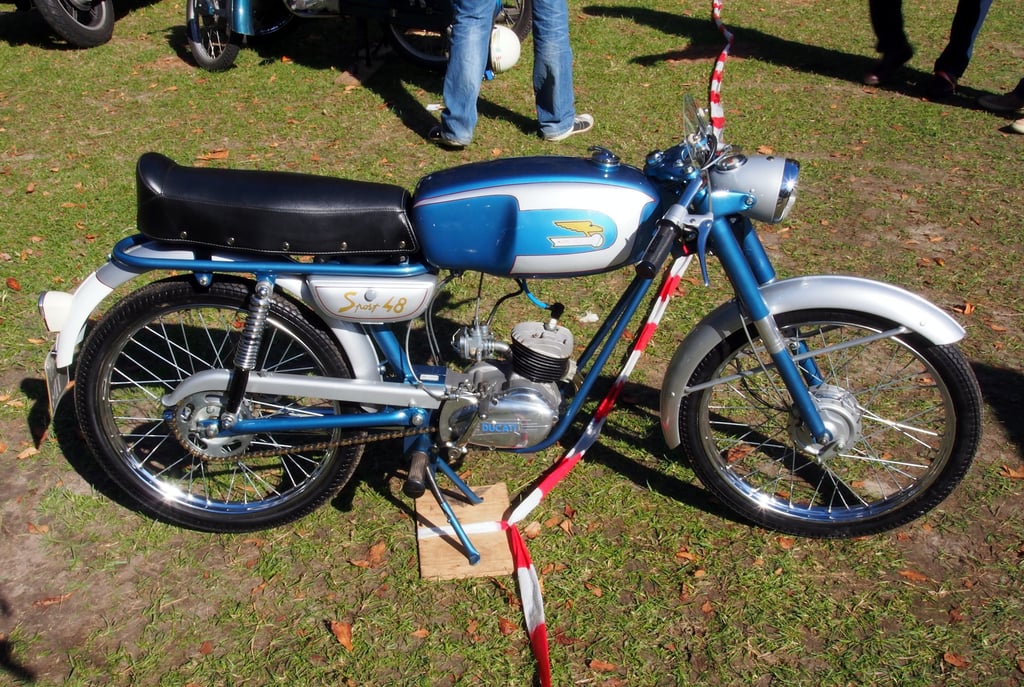Ducati: A Legacy of Innovation and Performance
Ducati, the iconic Italian motorcycle manufacturer, has a rich history of innovation and performance. From its beginnings as a radio components producer, Ducati evolved into a major player in the motorcycle industry. The company faced challenges during World War II but persevered and continued production. In the 1950s, Ducati entered the motorcycle market with the introduction of the first Ducati motorcycle. The 1960s and 1970s marked significant milestones for Ducati with the introduction of the Mach 1 and the revolutionary desmodromic valve design. Ownership of Ducati changed hands multiple times over the years, with Audi's subsidiary Lamborghini acquiring the company in 2012. Ducati is known for its high-performance motorcycle designs, including the iconic L-twin engine and desmodromic valve system. The brand has a strong racing heritage, achieving success in MotoGP and the Superbike World Championship. Ducati has also built a vibrant community of enthusiasts worldwide.
CYCLEMOTORSDUCATIITALY 1950'S1940'SMOTORCYCLES
12/18/20233 min read


Ducati: A Legacy of Innovation and Performance
Ducati, an iconic Italian motorcycle manufacturer, has etched its name in the annals of motorcycling history with a legacy spanning nearly a century. From its humble beginnings as a radio components producer to its current status as a powerhouse in the motorcycle industry, Ducati's journey is one of resilience, innovation, and a relentless pursuit of excellence.
Early Years and Evolution:
Founded in 1926 by Antonio Cavalieri Ducati and his three sons, Ducati initially focused on producing vacuum tubes, condensers, and other radio components under the name Società Scientifica Radiobrevetti Ducati (SSR Ducati). However, the company's trajectory changed during World War II when the Borgo Panigale factory became a target for Allied bombing, culminating in its destruction in 1944. Despite the challenges, Ducati persevered and continued production.
Post-war, Ducati found success with the "Cucciolo," a small pushrod engine developed in collaboration with Turinese firm SIATA. This engine, initially designed for bicycles, paved the way for Ducati's entry into the motorcycle market in 1950. The first Ducati motorcycle, a 48 cc bike, was born, marking the beginning of a new era for the company.
As the market shifted towards larger motorcycles, Ducati adapted and introduced the 65TS cycle and Cruiser in 1952. However, the Cruiser faced limited success, leading to the company's decision to split into two entities in 1953: Ducati Meccanica SpA and Ducati Elettronica, acknowledging the divergence of motorcycle and electronics product lines.
The 1960s and 1970s: A Racing Legacy Begins:
Ducati's golden era in the 1960s saw the introduction of the Mach 1, the fastest 250 cc road bike of its time. The 1970s marked a significant milestone with the introduction of large-displacement V-twin engines branded as "L-twin," and the revolutionary desmodromic valve design in 1973. This innovative valve system, eliminating valve springs, became a trademark of Ducati motorcycles.
In 1985, Ducati's ownership changed hands as Cagiva acquired the company, but the Ducati name persisted. Eleven years later, in 1996, Texas Pacific Group took control, leading to Ducati's initial public offering in 1999. A subsequent shift in ownership occurred in 2005 when Investindustrial Holdings acquired Ducati.
The Modern Era and Innovation:
In 2012, Ducati entered a new chapter when Volkswagen Group's Audi subsidiary acquired the company for €860 million, strengthening the ties between luxury car brand Lamborghini and Ducati. The acquisition marked the beginning of a new phase for Ducati under the ownership of Audi.
Ducati's motorcycle designs are characterized by high-performance features, including large-capacity four-stroke, 90° V-twin engines. The unique desmodromic valve design, trellis frame, and distinctive L-twin configuration have become synonymous with Ducati's commitment to innovation and performance.
Ownership Journey:
Since its inception in 1926, Ducati has undergone various ownership changes:
1926–1950: Ducati family
1950–1967: Government Istituto per la Ricostruzione Industriale (IRI) management
1967–1978: Government EFIM management
1978–1985: VM Group
1985–1996: Cagiva Group
1996–2005: Texas-Pacific Group (US-based) ownership and going public
2005–2008: Investindustrial Holdings S.p.A.
2008–2012: Performance Motorcycles S.p.A.
19 July 2012 – present: Automobili Lamborghini S.p.A. (via Audi's Automobili Lamborghini subsidiary)
Motorcycle Designs and Innovations:
Ducati's motorcycle lineup spans a wide range, including the Monster series, Streetfighter, Multistrada, Diavel, Panigale, SuperSport, Hypermotard, and Scrambler. The brand is renowned for its use of the L-twin engine, desmodromic valve system, and distinctive trellis frame.
Racing Dominance:
Ducati's racing heritage is illustrious, with notable achievements in MotoGP and the Superbike World Championship (SBK). In 2007, Casey Stoner secured Ducati's first Grand Prix World Championship, showcasing the brand's prowess in the premier class. The SBK series has witnessed Ducati's dominance, winning multiple riders' and manufacturers' championships, solidifying its status as a powerhouse in production-based motorcycle racing.
Community and Enthusiast Culture:
Ducati has fostered a strong community identity, with over 400 Ducati clubs worldwide and a robust online presence. Enthusiasts, often referred to as Ducatista, embody the brand's spirit, contributing to the unique culture surrounding Ducati motorcycles.
Conclusion:
Ducati's journey from a small radio components manufacturer to a global motorcycle icon reflects its ability to adapt, innovate, and push the boundaries of performance. With a commitment to technological excellence, racing success, and a passionate community, Ducati continues to shape the world of motorcycling, ensuring its place among the most revered and iconic motorcycle brands.
